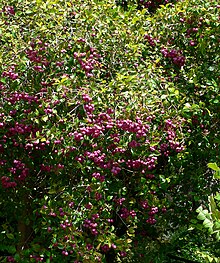
Syzygium is a genus of flowering plants that belongs to the myrtle family, Myrtaceae. The genus comprises about 1200 species, and has a native range that extends from Africa and Madagascar through southern Asia east through the Pacific. Its highest levels of diversity occur from Malaysia to northeastern Australia, where many species are very poorly known and many more have not been described taxonomically. One indication of this diversity is in leaf size, ranging from as little as a half inch to as great as 4 ft 11 inches by sixteen inches in Syzygium acre of New Caledonia.

Syzygium paniculatum, the magenta lilly pilly or magenta cherry, is a species of flowering plant in the myrtle family Myrtaceae, native to New South Wales, Australia. A broad dense bushy rainforest tree, in cultivation it grows to a height of 15 m (49 ft) with a trunk diameter up to 35 cm (14 in). The largest known example is at Ourimbah Creek, 35 m (115 ft) metres tall. The leaves are 3–9 cm (1.2–3.5 in) long, opposite, simple and slightly obovate, tapering at the leaf base. They are dark glossy green above, and paler below. White flowers are produced in clusters. The edible fruit is usually magenta, but can be white, pink or purple. The seeds are polyembryonic.
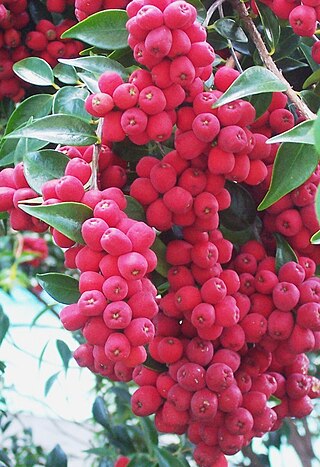
Syzygium luehmannii is a medium-sized coastal rainforest tree native to Australia. Common names include riberry, small leaved lilly pilly, cherry satinash, cherry alder, or clove lilli pilli.

Fletchers Glen is a small but mature temperate rainforest in Bouddi National Park in New South Wales, Australia. It provides habitat for two threatened plant species — the Magenta Lily Pilly and the Paperbark as well as the only locally known population of Snowwood.

Archontophoenix cunninghamiana – commonly known as Bangalow palm, king palm, Illawara palm or piccabeen palm – is a tree in the palm family Arecaceae which is endemic to the east coast of New South Wales and Queensland, Australia.

Syzygium oleosum, common names include blue lilly pilly, Scented satinash, and blue cherry. It is a species of Syzygium tree native to the eastern Australian rainforests and wet sclerophyll forests.

Syzygium australe, with many common names that include brush cherry, scrub cherry, creek lilly-pilly, creek satinash, and watergum, is a rainforest tree native to eastern Australia. It can attain a height of up to 35 m with a trunk diameter of 60 cm. In cultivation, this species is usually a small to medium-sized tree with a maximum height of only 18m.

Glochidion ferdinandi, with common names that include cheese tree, is a species of small to medium–sized trees, constituting part of the plant family Phyllanthaceae. They grow naturally across eastern Australia, from south–eastern New South Wales northwards to northern and inland Queensland, in rainforests and humid eucalypt forests. Frugivorous birds such as pigeons, figbirds and parrots consume its fruit.

Syzygium moorei is a rare sub tropical rainforest tree, growing on volcanic soils in the Mount Warning area of north east New South Wales and south east Queensland, Australia. Common names include coolamon, watermelon tree, durobby and robby; it is also called "rose apple" but this can refer to many species of Syzygium.
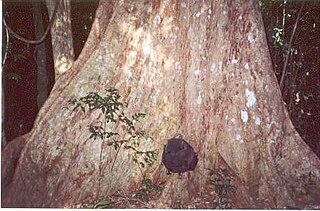
Syzygium francisii is a native Australian tree, common on the eastern sea board, between Morisset, New South Wales and Gladstone, Queensland. Common names include giant water gum, rose satinash, and Francis water gum. The habitat of Syzygium francisii is rainforest on basaltic or fertile alluvial soils.

Syzygium floribundum, synonym Waterhousea floribunda, is a rainforest tree of eastern Australia. It grows along streams from the Williams River near Dungog to Mackay in central eastern Queensland. Known as the weeping lilli pilli, this tree is widely planted as an ornamental. Planted trees from 1827 may be seen at the Royal Botanic Gardens, Sydney. However, these trees are damaged and threatened by the roosting grey headed flying foxes. A very large tree is located at Western Park in Auckland, New Zealand.
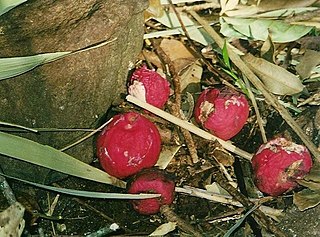
Syzygium ingens, commonly known as red apple, is a species of flowering plant that is endemic to eastern Australia. It is a medium-sized to tall rainforest tree with narrow elliptic to oblong leaves and panicles of white flowers on the ends of branchlets, followed by spherical red berries.

Syzygium hodgkinsoniae is a rare subtropical rainforest tree, growing on alluvial soils by streams in the north east New South Wales and south east Queensland, Australia. The range of natural distribution is from the Richmond River, New South Wales to Gympie in south east Queensland. Common names include smooth-bark rose apple or red lilly pilly.

Syzygium hemilamprum, commonly known as the broad-leaved lilly pilly, blush satinash, cassowary gum, Eungella gum, and treated as Acmena hemilampra in New South Wales and Queensland, is a species of flowering plant in the family Myrtaceae and is native to New South Wales, Queensland and the Northern Territory. It is a rainforest tree with broadly lance-shaped to elliptic leaves, panicles of white flowers and more or less spherical white fruit.
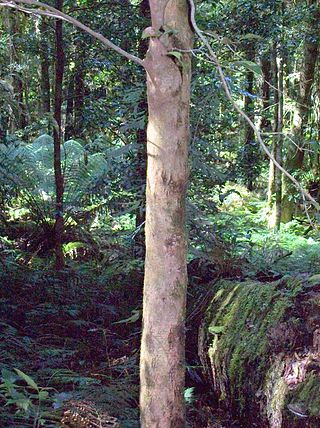
Gossia acmenoides, known as the scrub ironwood, is a rainforest tree of the family Myrtaceae, native to eastern Australia. The usual habitat of this small tree is drier rainforest areas. The range of natural distribution is from Jamberoo in New South Wales to Eungella National Park in northern Queensland.

Acronychia laevis, commonly known as hard aspen, glossy acronychia or northern white lilly pilly, is a species of shrub or small tree in the citrus family, and is endemic to eastern Australia. It has simple, elliptical to egg-shaped leaves, groups of creamy white flowers and fleshy, mitre-shaped to spherical fruit.

Decaspermum humile, commonly known as the silky myrtle, is a tree from Australia and Asia. It can be used as bush food, as indicated by the alternate common name of currant myrtle. The tree features an attractive dark glossy crown. The new pink leaves with silvery hairs are particularly appealing.

Syzygium alliiligneum, commonly known as onionwood, Mission Beach satinash or bark in the wood is a species of plant in the family Myrtaceae. It is endemic to a small part of north eastern Queensland.

Syzygium forte, commonly known as flaky-barked satinash, white apple or brown satinash, is a tree in the family Myrtaceae native to New Guinea and northern Australia.

Syzygium unipunctatum, commonly known as the rolypoly satinash, is a small tree in the family Myrtaceae. It is endemic to the rainforests of the Wet Tropics of Queensland.
